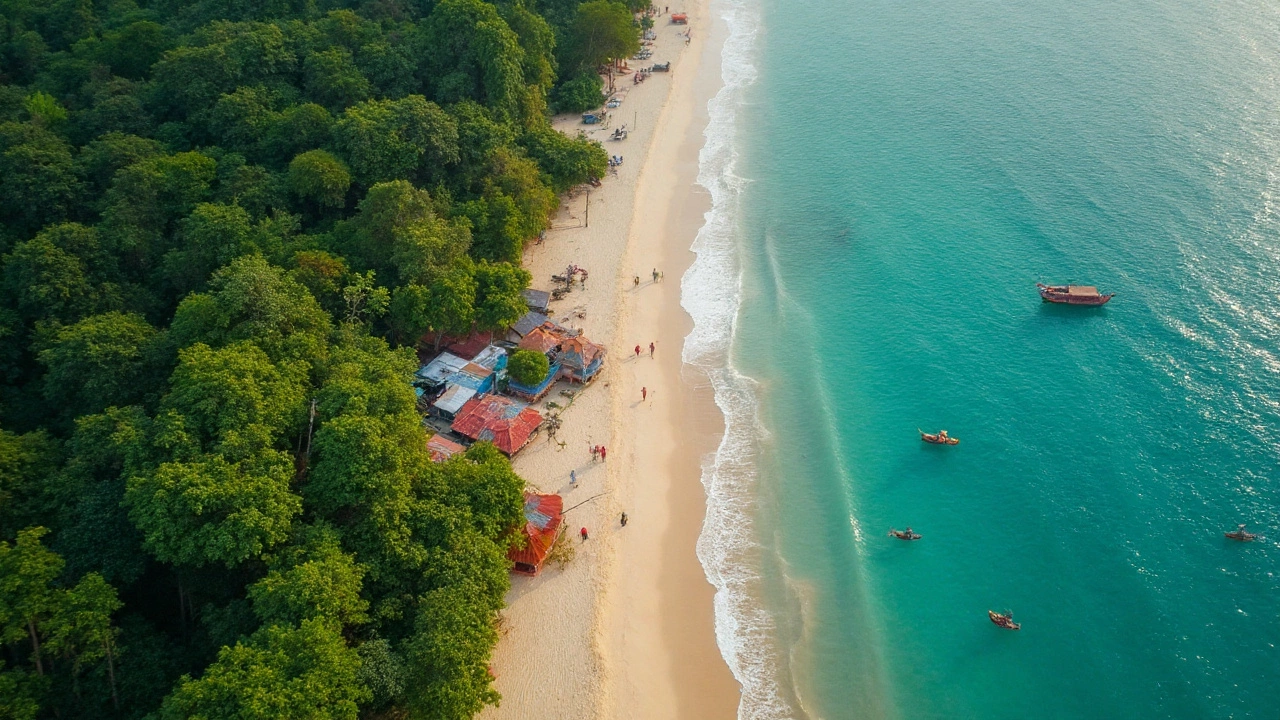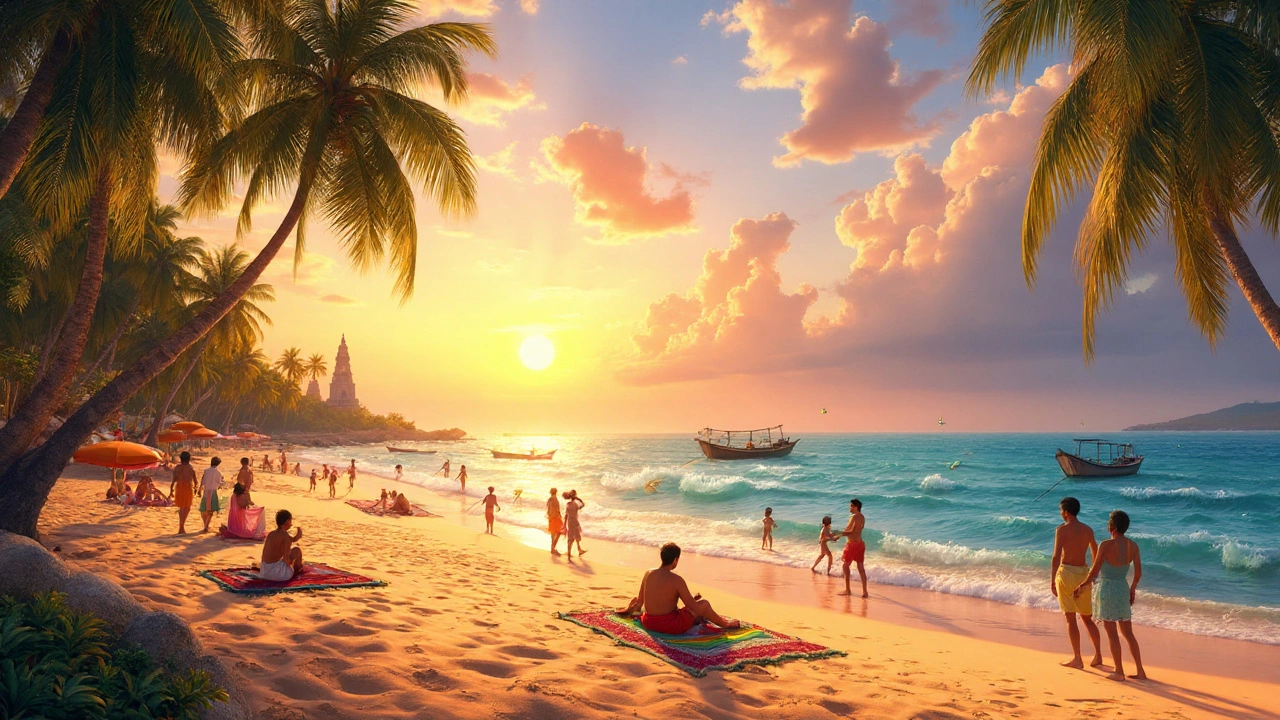Picture this: you’re sitting with your toes dug in hot white sand, coconut trees swaying overhead, the turquoise water sending in splash after lazy splash. Most folks think about the Maldives or somewhere in the Caribbean when this dream flickers up, but here’s a little shocker—India is home to tropical beaches that rival any you’ll find abroad. Ask my son Linus, who judges every beach by the availability of coconut water and chaseable crabs—he says India’s have both, and plenty more besides.
Understanding India’s Coast: Where Tropical Begins
India’s southern coastline stretches more than 7,500 km, officially making it one of the longest in the world. But not every inch is tropical. Here, “tropical beaches” means those between the Tropic of Cancer and the Equator. You want palms, warm year-round water, plenty of sun, and enough humidity to frizz your hair into submission. That’s the tropical recipe.
Most of India’s genuine tropical beaches sit in states like Goa, Kerala, Tamil Nadu, Karnataka, and, most uniquely, the Andaman and Nicobar Islands, alongside the Lakshadweep archipelago. While you’ll find sandy stretches on the west and east coasts, the swaying palms and bathwater-warm seas that slap you into holiday mode are clustered in these points. Let’s look at a quick breakdown—
| Region | Famous Tropical Beaches | Average Water Temp (°C) | Main Attraction |
|---|---|---|---|
| Goa | Palolem, Agonda, Baga | 28 | Party, Shacks, Sunsets |
| Kerala | Kovalam, Varkala, Marari | 27 | Cliffs, Ayurveda, Backwaters |
| Andaman | Radhanagar, Elephant Beach | 29 | Coral Snorkeling, Pristine Sands |
| Lakshadweep | Agatti, Bangaram | 30 | Lagoon, Diving |
| Tamil Nadu | Mahabalipuram, Rameswaram | 28 | Culture, Calm Waters |
It’s not just geography, though. The vibe, how the air smells, what grows right up to the sand—it all screams "tropical." Palms, casuarinas, and all those noisy birds you only see in nature documentaries flit around. You’ll find the real thing, not just a beach with warm weather.
The Crowded Gems: Goa and Kerala
Goa grabs the headline every time someone types "beach" and "India" into Google. Its claim to fame is not just long stretches of powdery sand, but the feeling there’s always something happening. Think live music bouncing off beach shacks, plates of spicy prawn curry, and enough cashew feni to send anyone singing into the moonlight. The best part? Underneath the tourist buzz, you can still carve out pockets of solitude, especially in the south—try Palolem or Agonda if you want the tropical look without feeling like you’re in a beachside traffic jam.
If you’re after something more laid-back, where families flick frisbees instead of rave lights, Kerala’s beaches dial it down a notch. Varkala’s famous for its dramatic red cliffs—a proper jaw-dropper when you first see the Arabian Sea crashing below. Grab a fresh lime soda, watch paragliders float, or just marvel at the sheer number of colors at sunset. Kovalam’s worth a stop if you’re curious about beachside Ayurveda massages (my son Linus hated the smell, but swears his knees never felt better afterward).
There’s also something about Kerala’s food. Simple grilled fish, appam (sort of like a fermented pancake), coconut everywhere. Most beach shacks here serve both local nosh and an oddly convincing pizza, but skip the international menu and stick to what just came off a boat. Plus, there are smaller, almost secret beaches like Marari, or the green water’s edge at Bekal under a looming fort. If you’re looking for tropical, this stretch is a little slice of southern comfort—with more elephants than I ever expected to see on a holiday.

Hidden Paradises: The Islands Offshore
India’s mainland beaches are great, but you’ll find the real jaw-droppers far out in the Andaman Sea or the Arabian Sea. The Andaman and Nicobar Islands, a good two-hour flight from Chennai or Kolkata, are all coconut groves and powdery sand, with a wild sense of untouched nature. Radhanagar Beach on Havelock (now renamed Swaraj Dweep) is regularly called one of the best beaches in Asia. I’m not talking "pretty good for an Indian beach"—I mean magazine-cover, crystal-clear, blue-lagoon vibes that seem almost edited in photos.
Here, you can walk for ages and only meet a hermit crab or two. The water is glassy, and snorkeling brings you face-to-face with neon-colored fish and coral gardens. Elephant Beach, despite the name, is known for its marine life, not tuskers—but if all you want is a hammock, a book, and a chance to completely reboot, you can do that too. The sand’s so fine it squeaks under foot, and the forests behind hide ancient trees and the loudest insects I’ve ever heard.
The Lakshadweep Islands are harder to reach, but some people say they’re worth every bit of hassle. Flights connect to Agatti, and you’ll find lagoons that light up in every shade of blue. It’s not built-up—think more Robinson Crusoe than Miami. The diving here is world-class, thanks to reefs untouched by big crowds. If you do make it out, the islands like Bangaram and Kavaratti have beaches that could swap places with anything in Southeast Asia and nobody would notice. Permits are a must, and choices for where to stay are slim, but that’s also the point—you get the place (almost) to yourself.
Both these archipelagos lie well within the tropical zone, and the water is so warm you may sweat before you get wet. For wildlife lovers, sea turtles, dolphins, and dozens of bird species make appearances with little fanfare. It’s as close as you can get to an untouched tropical paradise without needing a private yacht or a billionaire dad.
Making the Most of India’s Tropical Beaches
So, you know India has tropical beaches—what’s next? First, don’t just follow the crowd. The best time for most of these sunny stretches is November to March. After that, the monsoon rolls in, turning the sea into a drama queen. If you love a wild, rainy, romantic mood (and less competition for lounge chairs), June to September gives you that moody, post-card vibe. Kerala’s beaches explode into green, fisherfolk head out even in serious downpours, and you might get more beach to yourself—but swimming’s risky, as currents go mad.
Dress code is chill. For men, shorts and a tee—if anything—work fine, and women can go swimwear on the beach but will probably be comfier walking the lanes with a wrap or cover-up. Sun protection is not optional. Trust me, Indian sun at the fifteenth parallel can roast you faster than a tandoor. Slap on a hat and reef-safe sunscreen (protects those coral reefs Linus was so keen to chase fish across).
Getting around can be an adventure. Local taxis, rickshaws, mopeds for the brave. For island-hopping, government ferries are slow but steady, while private boats go fast—just double-check safety gear if you’re in the Andamans or Lakshadweep. Bookings in advance are wise, especially over Christmas and January, when half of Europe seems to descend for the sunshine.
Don’t miss night swims under bioluminescent plankton—especially on Havelock in the Andamans, when the sea actually lights up blue if you move your hands. Kids lose their minds, and it beats any souvenir.
- Always respect red flags on beaches—currents can be sneaky and strong.
- Island tap water isn’t safe to drink; grab bottled or filtered.
- Watch for turtle nesting seasons, and avoid disturbing sites marked off with tape.
- Some beaches, like Varkala and Agonda, run turtle conservation projects visitors can join for a few hours.
- Street food on the beach is tasty but stay hydrated and try stalls with more locals than tourists.
Here’s the wildcard: if you’re bored of just lying around (kids get twitchy after an hour), try surfing lessons in Varkala, or go kayaking in the Kerala backwaters. Goa offers everything from silent headphone parties on Palolem Beach to hot air balloon rides over the coast. And island-conquering folk will want to pack sturdy sandals—you’ll need them for exploring mangroves, secret lagoons, or just crossing an unexpected crab migration on your way back to the hammock.
The truth? India not only has India tropical beaches, it’s got some of the world’s best—yours to enjoy, explore, and brag about next time you’re swapping holiday stories. Just don’t forget the sunscreen, your sense of adventure, and maybe an extra memory card.
